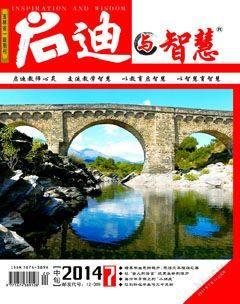牛津小學英語4A Unit 3 A purse教學設計
黃巧英
【課題】
4A Unit 3 A purse
【教材簡介】
本單元的日常交際用語是“確認所屬”,與該項目相結合的內容是形容詞性物主代詞。
本單元的另一個交際項目是“空間關系”,即人或物所處的位置,教師要創(chuàng)設一個合乎邏輯的語境,讓學生掌握空間關系的表達法。
【教學過程】
Step1. Warm up
1.Listen to the song: Where is Helen?
歌詞為“Where is Helen?Shes in the classroom. Where is David? Hes in the park.”
2.T:Shall we sing it now?(上課鈴響后立刻帶領學生齊唱歌曲。)
3.提問并復現單詞classroom,并導入開始上課。
T: WheresHelen?S: Shes in the classroom.
T: Where are we, now?S: …
T: Yes, were in the classroom. Were having an English lesson now. Shall we begin our class?
設計步驟說明:該步驟是準備階段,先用一首歌曲來調動學生的積極性,緊接著利用歌曲中的對唱復現單詞classroom,為下面課文的新授作了鋪墊。
Step2.Free talk.
1. T:Whats on your desk/chair?S:(教師引導幫助學生回答)Its a/an ... .
T:(繼續(xù)與學生交流)Can I have a look?
S:Sure. Here you are.
T:Thank you.
S:(教師啟發(fā)學生回答)Not at all.
[TEACH: Not at all.]
T:Let me see. What a nice …!
[TEACH: Let me see.]
(對話進行數個來回,幫學生在真實情景中學會使用文中出現的新的交際用語。)
2.T:(將上面與學生對話時拿來的一些物品通過請其他同學幫忙交還給本人)Come here, XX,your ...?
S: Yes,it is./No,it isnt .
T: Here you are./OK, this … is for XXX.(come here應注意與體態(tài)語言的配合)
[復現: Come here.]
3.三人小組操練以上句型。
設計步驟說明:在自由對話這個環(huán)節(jié)中,將本節(jié)課較為松散的交際用語重新整合了一段對話,主要的目的是利用英語學習的交際性來激發(fā)他們的興趣,激活他們的思維,同時對前面所學習知識進行適當的復習,也為下面的新授做一個鋪墊。
Step 3. Presentation and practice.
1.學新單詞 a purse:
T:Look, whats that over there?(利用課件呈現一個錢包,在此處也初步涉及到詞組over ther,讓學生進行感官的熟悉和初步的理解)
S:(師啟發(fā)回答)Its a purse.[TEACH: a purse與nurse發(fā)音對比 并揭示課題]
2.重點突破交際用語:A:Is that your……?
B:Yes, it is./No, it isnt. Perhaps its…
A:Wheres…?
B:Perhaps hes/shes in ….
T:Is that your purse?
S:(師啟發(fā)回答)No, it isnt.
T:(詢問數個學生后)Thats not your purse, I think. Lets go and find the owner, OK? Shall we ask Miss Li, first?
(教師板書句型,引導學生用Is that your purse?提問,practice in chains)
T:(讓學生齊問課件中的Miss Li)
You did a good job. That purse isnt yours, is it Miss Lis? Lets ask her together,OK?
S:Is that your purse?
Miss Li(利用課件進行人機對話):No, it isnt. Per-
haps its Davids.(利用課間呈現Perhaps的中文,并利用舊單詞ruler,cat對perhaps進行讀音的遷移,帶讀并出示含義)
T:OK! Lets go to ask David! Wheres David?(課件中發(fā)出“刷牙”的聲音)
S:(鼓勵學生用perhaps) Perhaps hes in the bath-
room.
T:(課件)Yes! Lets ask him together.
Ss: Hello, David. Is that your purse?
David(利用課件進行人機對話): No,it isnt .
T:Whose purse is it ?(思考狀)
S:(鼓勵學生用perhaps 來猜測)Perhaps its...s .
David(利用David的回答來揭示答案):No,it isnt .Perhaps its Gao Shans .
Ss:Hello, Gao Shan. Is that your purse?
Gao Shan:Let me see. Yes, it is .Thank you.
Ss:Not at all.
3.導入課文:
T:Congratulations! You find the owner!(利用課件呈現David和它的錢包)Whose purse is it?
S:Its Gao Shans.
T:Look! Heres another pink purse. Is this Gao Shans purse, too?(課件呈現課文中的粉紅色錢包)
T:Lets watch the cartoon, than youll get the answer.(課件播放A部分的卡通)
T:(讓學生默讀課文,找出文中不理解的詞句)Read silently the text then try to find the word you cant understand,underline the words. [TEACH: over there]
4. 操練課文對話內容:
T: Wonderful! This time, according to their conversation, can you put these pictures into the right order?(多媒體呈現四幅被打亂的課文圖片)
S: ( Put the pictures into the correct order.)
設計步驟說明:課文的導入仍與上個步驟一脈相承,通過高山的錢包過渡到無人認領的粉紅色的錢包,通過讓學生先去觀看課文動畫,感知他們,培養(yǎng)學生主動學習的能力。
Step 4.Consolidation.
1.Practice in pairs.(創(chuàng)設一個Lost property office 的情景)
2.Task.
利用課件呈現交際的任務“Helen 和朋友們在上學的路上撿到了一件綠色的sweater,會是誰的呢?”
S: Work in groups將故事續(xù)編下去。
設計步驟說明:教師先和學生做一個model,再讓學生來練習,這樣照顧到了大多數學生,尤其是有困難的學生。

